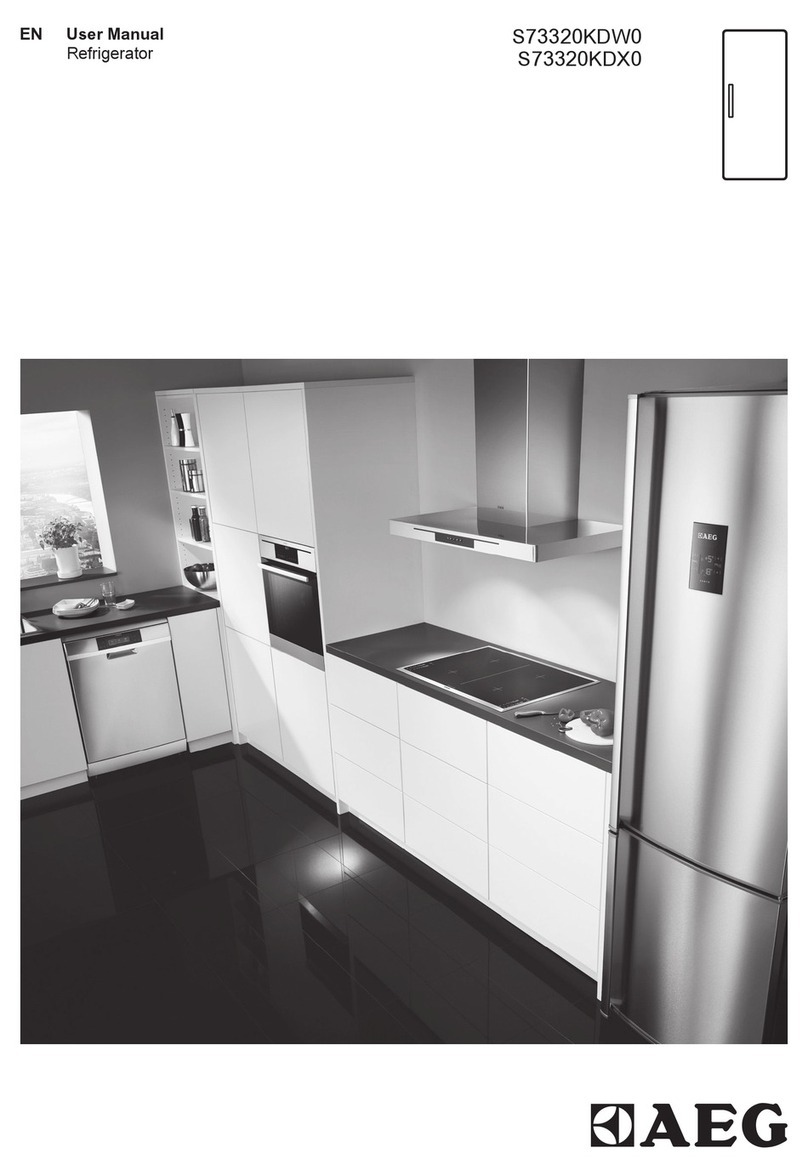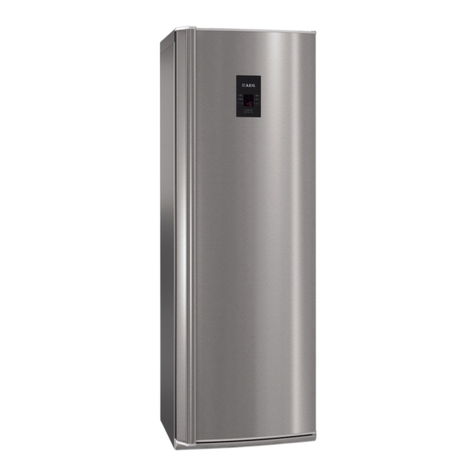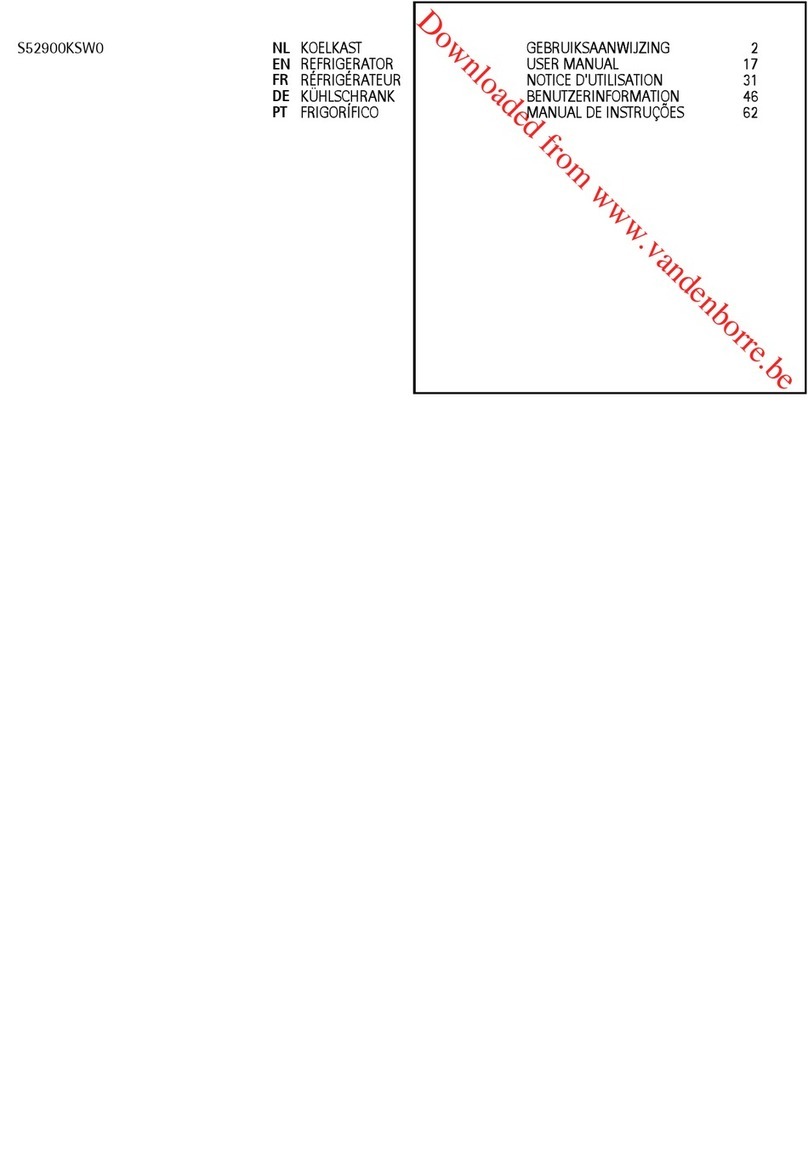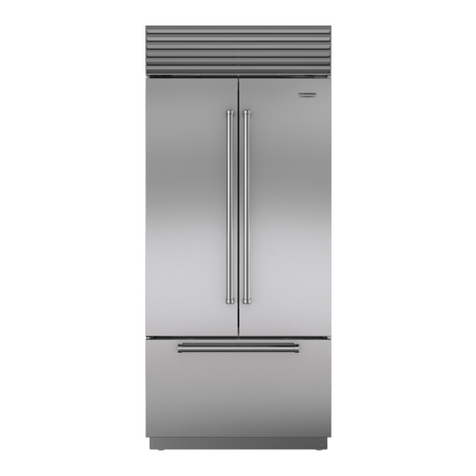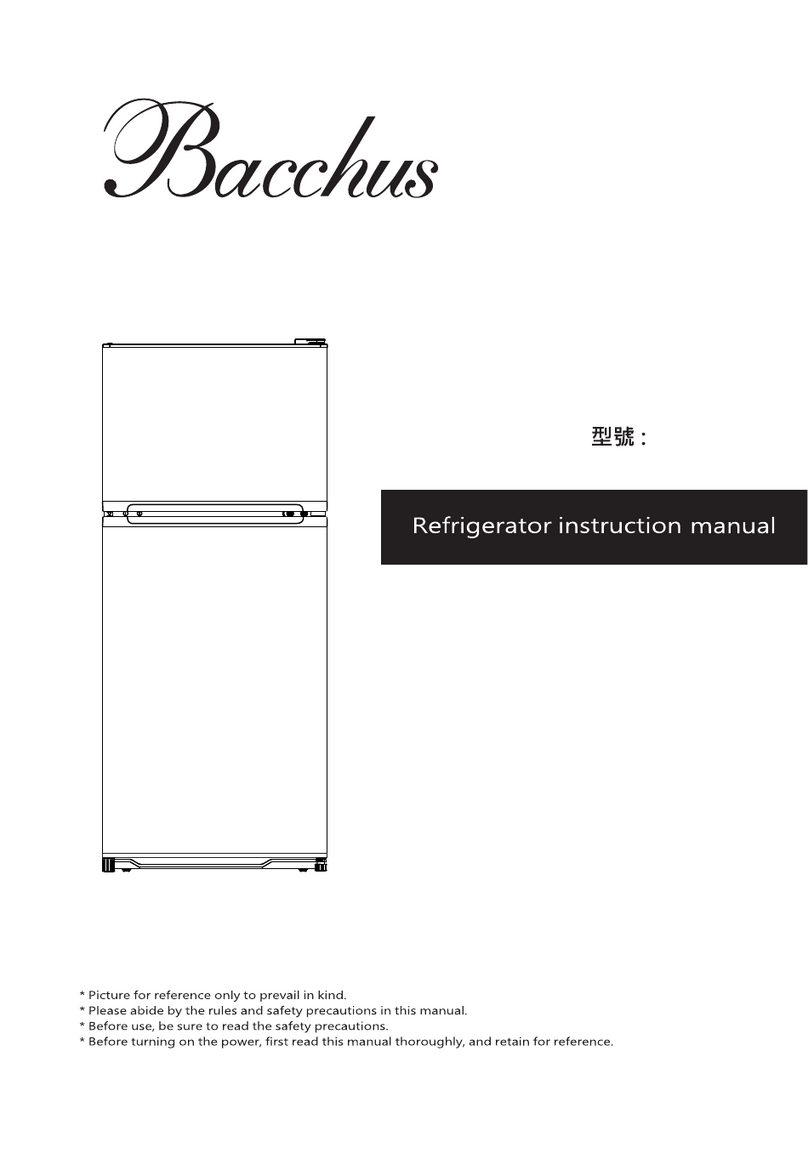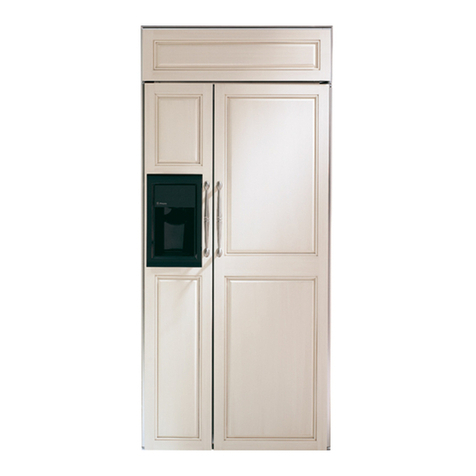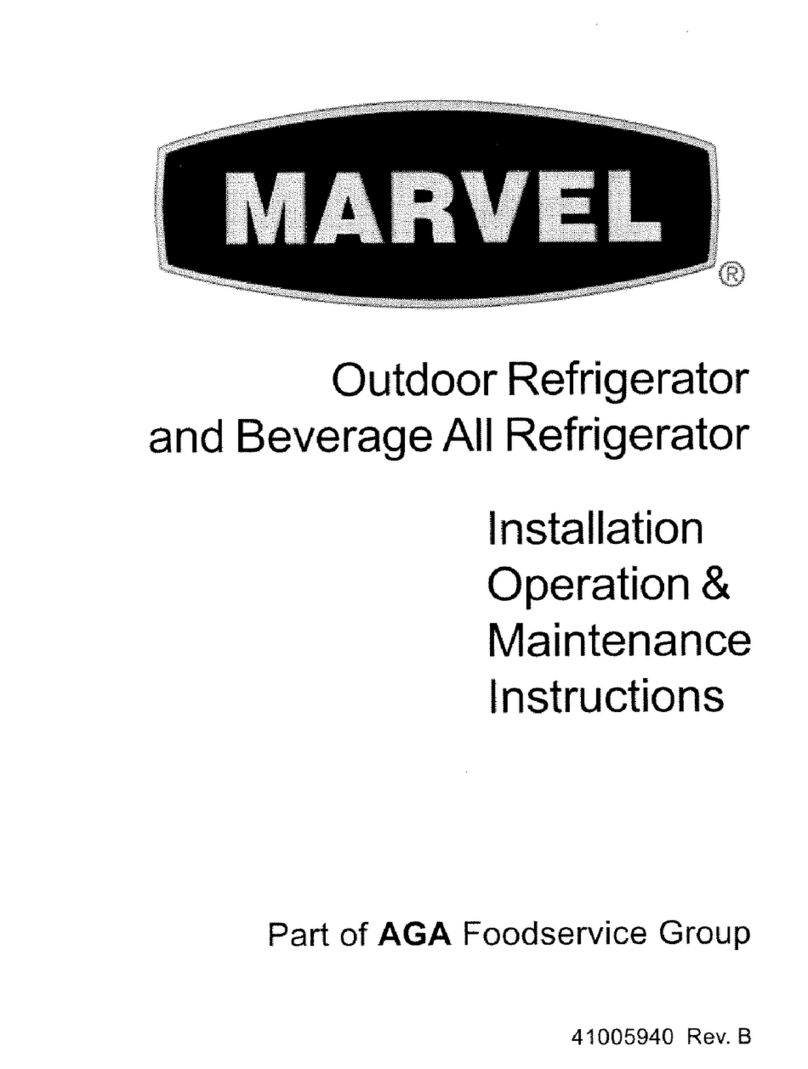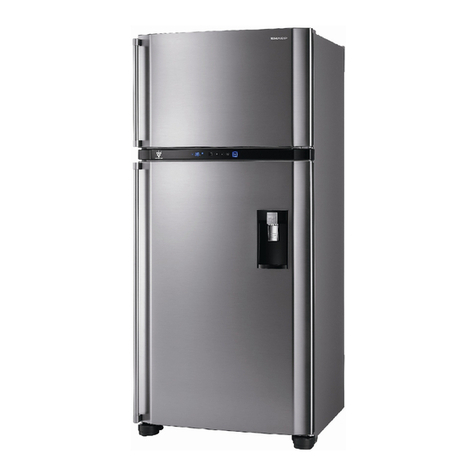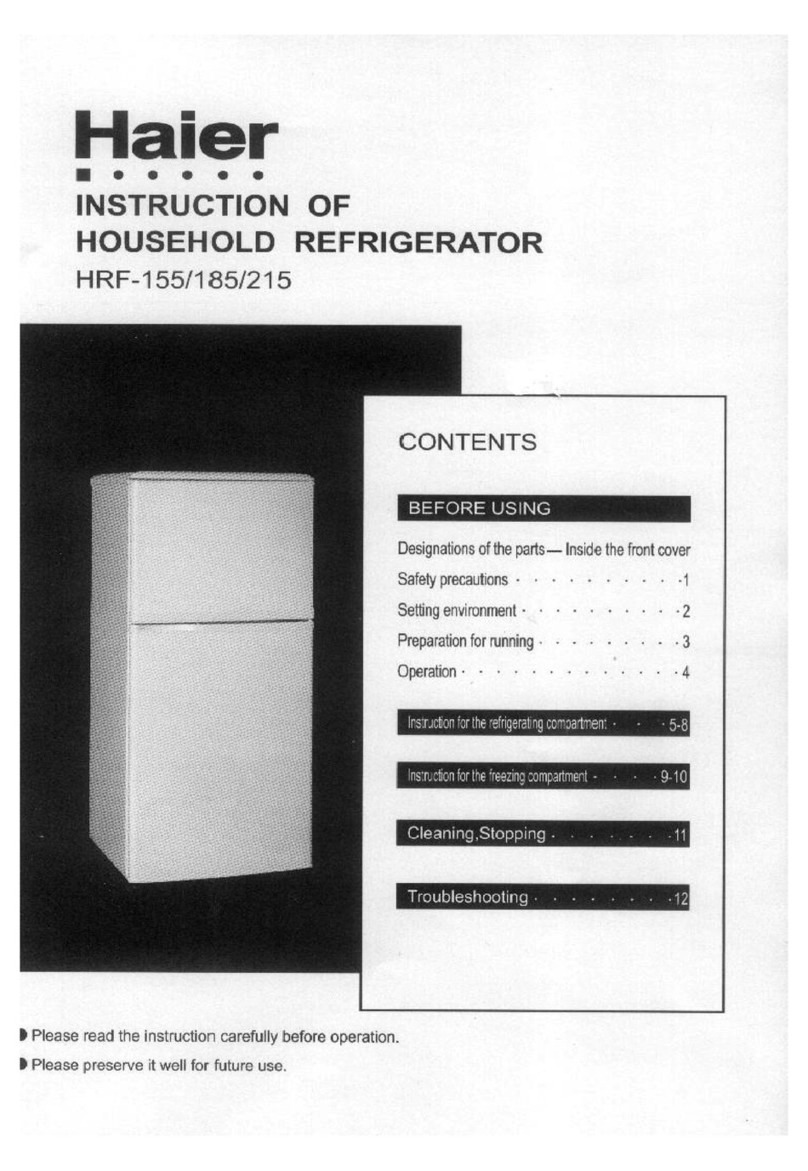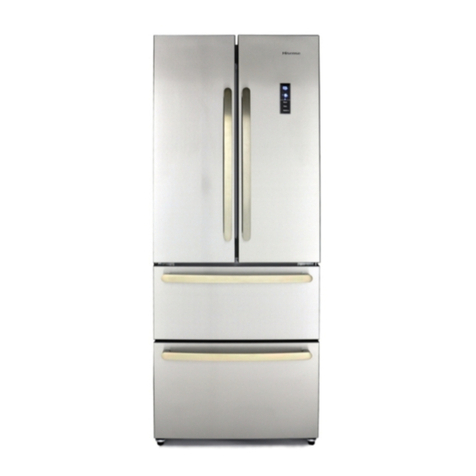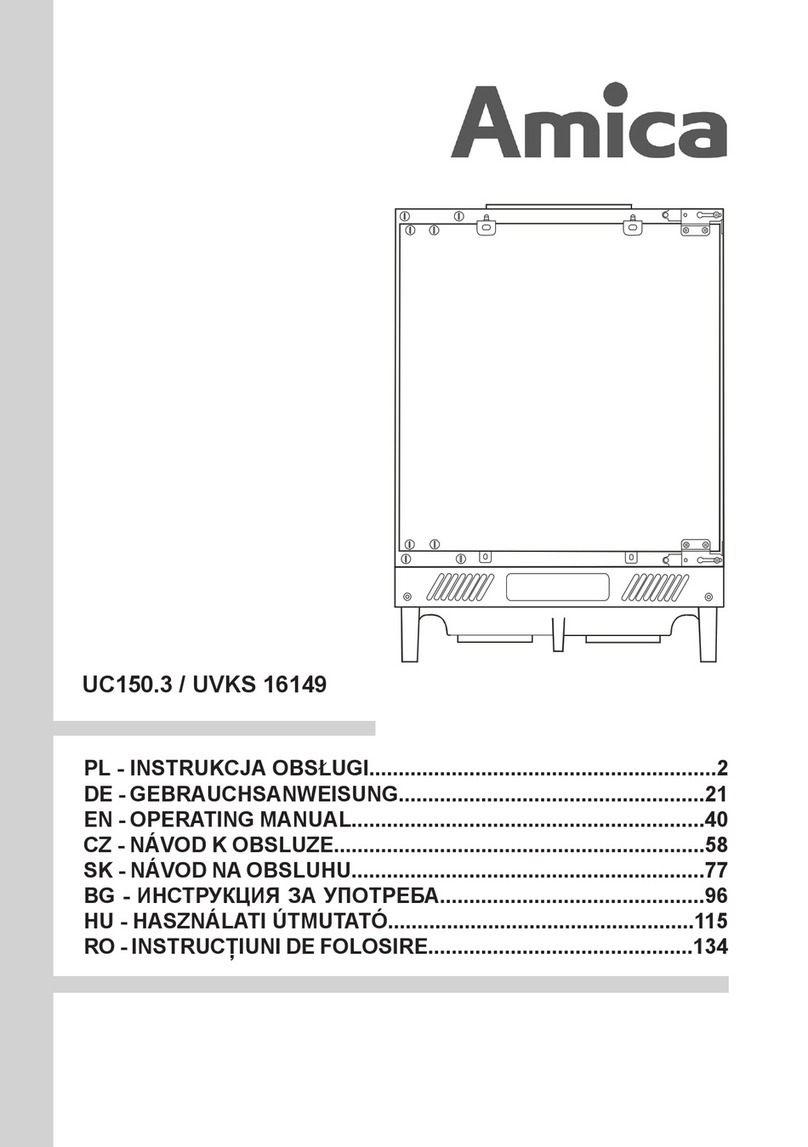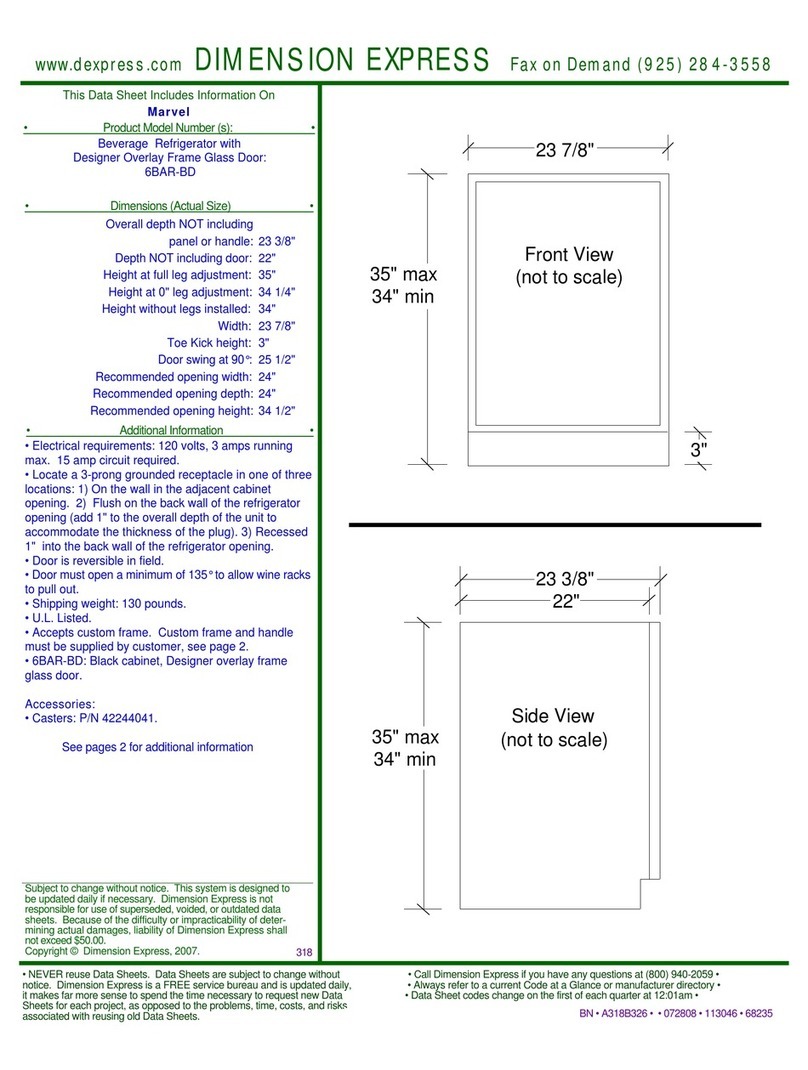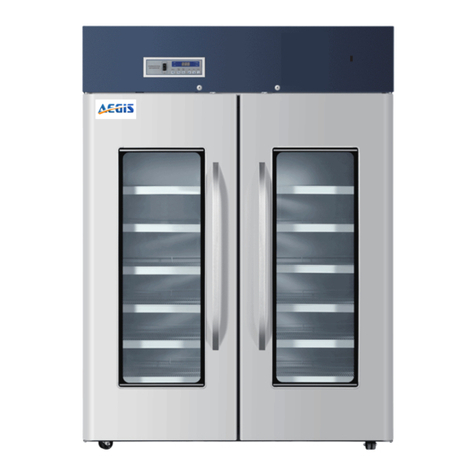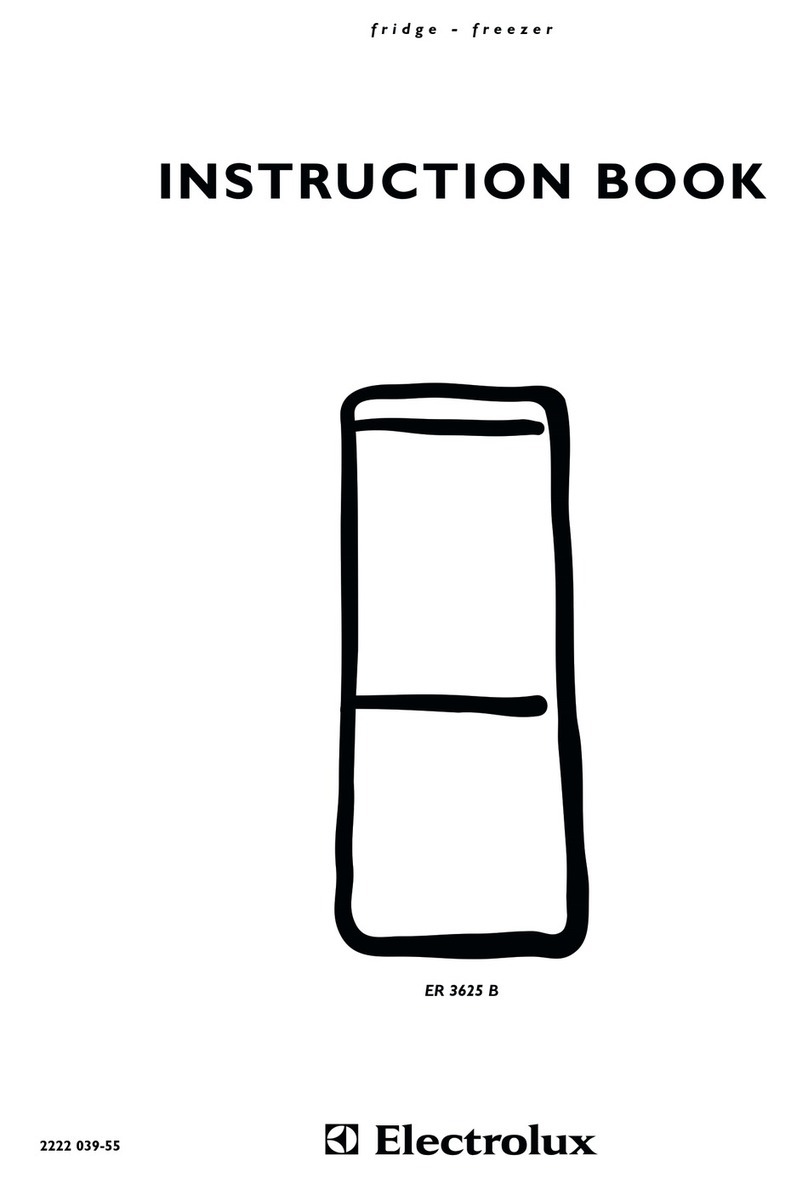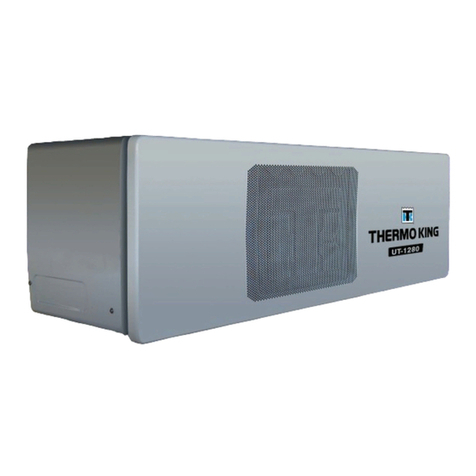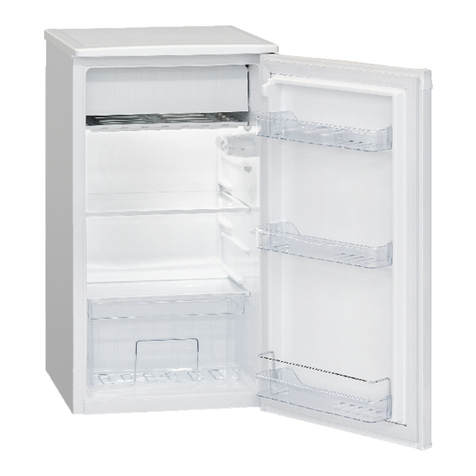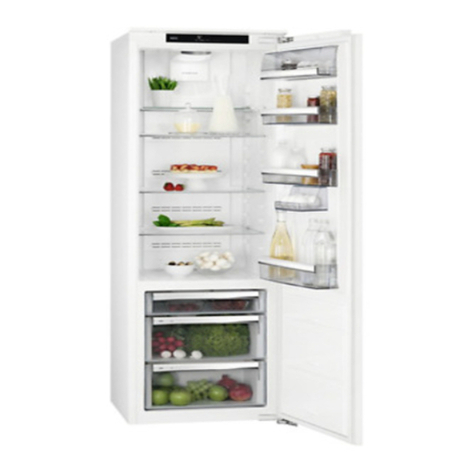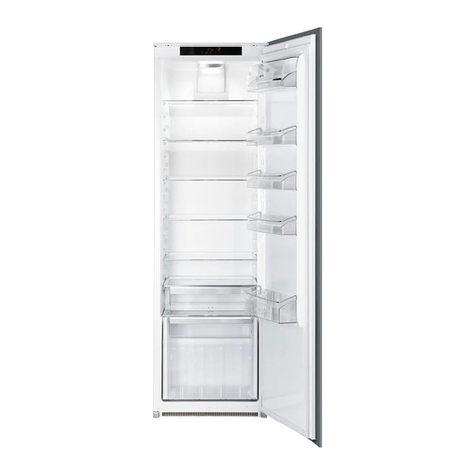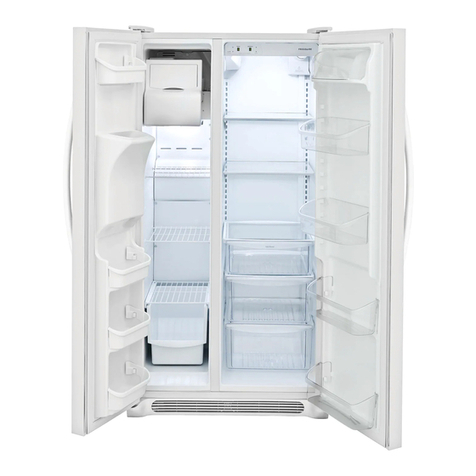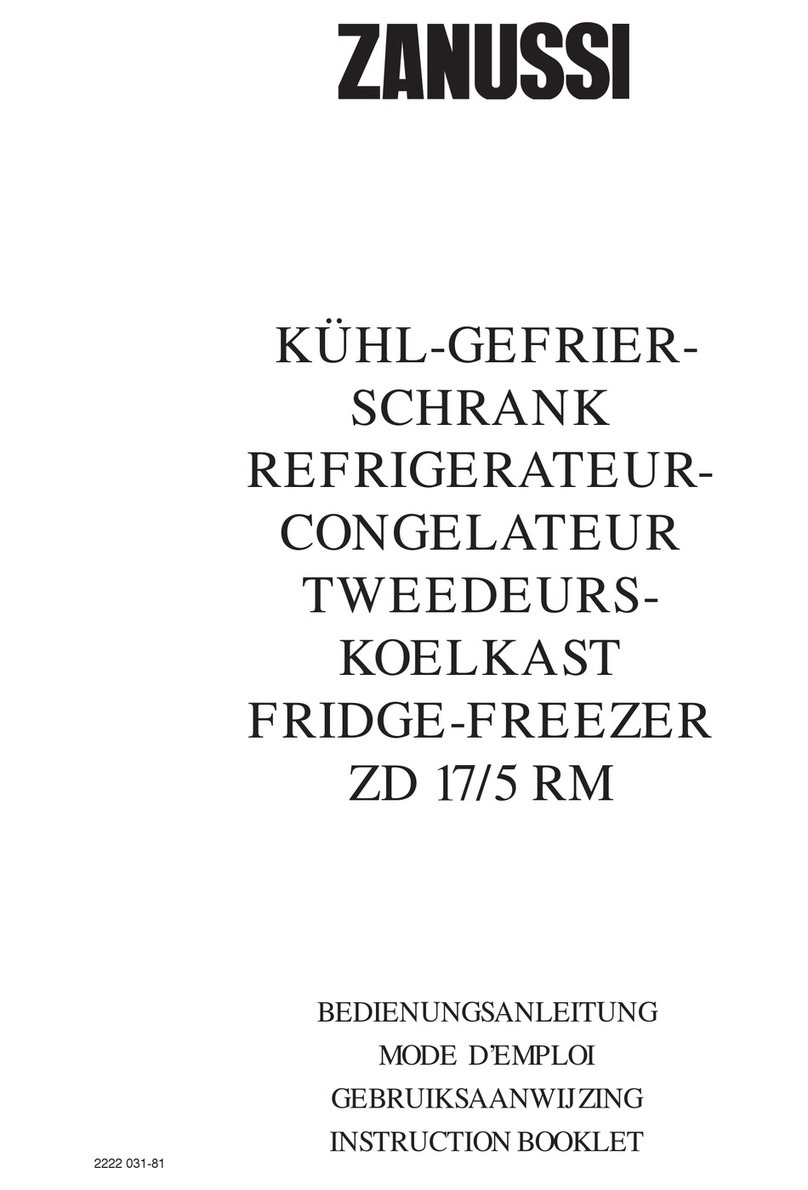AEG SANTO 70338-1KA User manual

SANTO 70338-1KA
User manual Refrigerator
Notice d'utilisation Réfrigérateur
Manual de instrucciones Frigorífico

Thank you for choosing one of our high-quality products.
To ensure optimal and regular performance of your appliance please read this
instruction manual carefully. It will enable you to navigate all processes perfectly
and most efficiently. To refer to this manual any time you need to, we recommend
you to keep it in a safe place. And please pass it to any future owner of the
appliance.
We wish you much joy with your new appliance.
CONTENTS
SAFETY INFORMATION 2
Children and vulnerable people safety 3
General safety 3
Daily use 4
Care and cleaning 4
Installation 4
Service 4
CONTROL PANEL 5
Switching on 5
Switching off 5
Temperature indicator 5
Temperature regulation 6
COOLMATIC function 6
FIRST USE 6
Cleaning the interior 6
DAILY USE 7
Movable shelves 7
Air cooling 7
Positioning the door half shelf 8
HELPFUL HINTS AND TIPS 8
Hints for energy saving 8
Hints for fresh food refrigeration 8
Hints for refrigeration 8
CARE AND CLEANING 9
Periodic cleaning 9
Defrosting of the refrigerator 9
Periods of non-operation 10
WHAT TO DO IF… 10
Replacing the lamp 12
Closing the door 12
TECHNICAL DATA 12
INSTALLATION 12
Positioning 12
Removing the shelf holders 13
Electrical connection 13
ENVIRONMENTAL CONCERNS 13
Subject to change without notice
SAFETY INFORMATION
In the interest of your safety and to ensure the correct use, before installing and first using
the appliance, read this user manual carefully, including its hints and warnings. To avoid
unnecessary mistakes and accidents, it is important to ensure that all people using the ap-
pliance are thoroughly familiar with its operation and safety features. Save these instruc-
tions and make sure that they remain with the appliance if it is moved or sold, so that ev-
eryone using it through its life will be properly informed on appliance use and safety.
For the safety of life and property keep the precautions of these user's instructions as the
manufacturer is not responsible for damages caused by omission.
2Contents

Children and vulnerable people safety
• This appliance is not intended for use by persons (including children) with reduced physi-
cal, sensory or mental capabilities, or lack of experience and knowledge, unless they have
been given supervision or instruction concerning use of the appliance by a person re-
sponsible for their safety.
Children should be supervised to ensure that they do not play with the appliance.
• Keep all packaging well away from children. There is risk of suffocation.
• If you are discarding the appliance pull the plug out of the socket, cut the connection
cable (as close to the appliance as you can) and remove the door to prevent playing chil-
dren to suffer electric shock or to close themselves into it.
• If this appliance featuring magnetic door seals is to replace an older appliance having a
spring lock (latch) on the door or lid, be sure to make that spring lock unusable before
you discard the old appliance. This will prevent it from becoming a death trap for a child.
General safety
CAUTION!
Keep ventilation openings clear of obstruction.
• The appliance is intended for keeping foodstuff and/or beverages in a normal household
as explained in this instruction booklet.
• Do not use a mechanical device or any artificial means to speed up the thawing process.
• Do not use other electrical appliances (such as ice cream makers) inside of refrigerating
appliances, unless they are approved for this purpose by the manufacturer.
• Do not damage the refrigerant circuit.
• The refrigerant isobutane (R600a) is contained within the refrigerant circuit of the appli-
ance, a natural gas with a high level of environmental compatibility, which is neverthe-
less flammable.
During transportation and installation of the appliance, be certain that none of the com-
ponents of the refrigerant circuit become damaged.
If the refrigerant circuit should become damaged:
– avoid open flames and sources of ignition
– thoroughly ventilate the room in which the appliance is situated
• It is dangerous to alter the specifications or modify this product in any way. Any damage
to the cord may cause a short-circuit, fire and/or electric shock.
WARNING!
Any electrical component (power cord, plug, compressor) must be replaced by a certified
service agent or qualified service personnel.
1. Power cord must not be lengthened.
2. Make sure that the power plug is not squashed or damaged by the back of the appli-
ance. A squashed or damaged power plug may overheat and cause a fire.
3. Make sure that you can come to the mains plug of the appliance.
4. Do not pull the mains cable.
5. If the power plug socket is loose, do not insert the power plug. There is a risk of elec-
tric shock or fire.
6. You must not operate the appliance without the lamp cover1) of interior lighting.
Safety information 3

• This appliance is heavy. Care should be taken when moving it.
• Do not remove nor touch items from the freezer compartment if your hands are damp/
wet, as this could cause skin abrasions or frost/freezer burns.
• Avoid prolonged exposure of the appliance to direct sunlight.
•Bulb lamps2) used in this appliance are special purpose lamps selected for household ap-
pliances use only. They are not suitable for household room illumination.
Daily use
• Do not put hot pot on the plastic parts in the appliance.
• Do not store flammable gas and liquid in the appliance, because they may explode.
• Appliance's manufacturers storage recommendations should be strictly adhered to. Refer
to relevant instructions.
Care and cleaning
• Before maintenance, switch off the appliance and disconnect the mains plug from the
mains socket.
• Do not clean the appliance with metal objects.
• Regularly examine the drain in the refrigerator for defrosted water. If necessary, clean
the drain. If the drain is blocked, water will collect in the bottom of the appliance.
Installation
For electrical connection carefully follow the instructions given in specific paragraphs.
• Unpack the appliance and check if there are damages on it. Do not connect the appli-
ance if it is damaged. Report possible damages immediately to the place you bought it.
In that case retain packing.
• It is advisable to wait at least four hours before connecting the appliance to allow the oil
to flow back in the compressor.
• Adequate air circulation should be around the appliance, lacking this leads to overheat-
ing. To achieve sufficient ventilation follow the instructions relevant to installation.
• Wherever possible the back of the product should be against a wall to avoid touching or
catching warm parts (compressor, condenser) to prevent possible burn.
• The appliance must not be located close to radiators or cookers.
• Make sure that the mains plug is accessible after the installation of the appliance.
•Connect to potable water supply only. 3)
Service
• Any electrical work required to do the servicing of the appliance should be carried out by
a qualified electrician or competent person.
• This product must be serviced by an authorized Service Centre, and only genuine spare
parts must be used.
1) If the lamp cover is foreseen.
2) If the lamp is foreseen.
3) If a water connection is foreseen.
4Safety information

Environment Protection
This appliance does not contain gasses which could damage the ozone layer, in either its
refrigerant circuit or insulation materials. The appliance shall not be discarded together
with the urban refuse and rubbish. The insulation foam contains flammable gases: the ap-
pliance shall be disposed according to the applicable regulations to obtain from your local
authorities. Avoid damaging the cooling unit, especially at the rear near the heat exchang-
er. The materials used on this appliance marked by the symbol are recyclable.
CONTROL PANEL
1 2 3 4 5 6 7
1. Pilot light
2. ON/OFF switch
3. Temperature regulator (warmest)
4. Temperature indicator
5. Temperature regulator (coldest)
6. COOLMATIC indicator
7. COOLMATIC switch
Switching on
1. Plug the mains plug into the mains socket.
2. Press ON/OFF switch.
3. The pilot light will light up.
Switching off
1. Keep ON/OFF switch pressed for more than 5 seconds.
2. After that, a countdown of the temperature from -3 -2 -1 will be shown. When “1”
appears the appliance is turned off. The temperature indicator switches off. The Pilot
light switches off.
Temperature indicator
The temperature indicator shows several information:
• During normal operation, the temperature indicator shows the current temperature in-
side the fridge (ACTUAL temperature). The ACTUAL temperature is indicated with illumi-
nated numbers.
• During temperature adjusting operation, the temperature indicator shows the fridge
temperature currently set (DESIRED temperature). The DESIRED temperature is indicated
by flashing numbers.
Control panel 5

Temperature regulation
To operate the appliance, proceed as follows:
1. Set the required temperature by pressing the corresponding temperature regulator. The
temperature indicator will immediately show the changed setting (DESIRED tempera-
ture) and the temperature indicator flashes.
2. Each time the temperature regulator is pressed the DESIRED temperature is adjusted by
1 °C. The DESIRED temperature must be reached within 24 hours.
3. Once the required temperature has been set, after a short period (approx. 5 sec.) the
temperature indicator will show again the current ACTUAL temperature inside the cor-
responding compartment. The temperature indicator will change from flashing to con-
tinuous illumination.
For a correct storage of the food the following temperature should be set:
• +5 °C in the fridge
When the setting is changed, the compressor does not start immediately if automatic de-
frosting is currently taking place. As the storage temperature within the fridge is reached
quickly you can store food immediately after switching on.
COOLMATIC function
The COOLMATIC function is suitable for quick cooling of large quantities of goods in the
refrigerator.
To activate the function, do these steps:
1. Press the COOLMATIC switch.
2. The COOLMATIC indicator will light up.
3. A temperature setting of +2°C is automatically selected.
To deactivate the function, do these steps:
1. Press the COOLMATIC switch.
2. The COOLMATIC indicator goes out.
The COOLMATIC function stops automatically after about 6 hours.
If the COOLMATIC function is switched on the temperature setting may not be changed.
FIRST USE
Cleaning the interior
Before using the appliance for the first time, wash the interior and all internal accessories
with lukewarm water and some neutral soap so as to remove the typical smell of a brand-
new product, then dry thoroughly.
Do not use detergents or abrasive powders, as these will damage the finish.
6First use

DAILY USE
this appliance is sold in France.
In accordance with regulations valid in this country it must be provided with a special de-
vice (see figure) placed in the lower compartment of the fridge to indicate the coldest zone
of it.
Movable shelves
The walls of the refrigerator are equipped with a
series of runners so that the shelves can be posi-
tioned as desired.
For better use of space, the front half-shelves can
lie over the rear ones.
Air cooling
The Dynamic Air Cooling (DAC) fan let food cool
quickly and a more uniform temperature in the
compartment.
1. You can switch on the fan by pressing the
switch (A). The green light comes on.
This device allows for rapid cooling of foods and a
more uniform temperature in the compartment.
Switch on the fan when the ambient temperature
exceeds 25°C.
A
Daily use 7

Positioning the door half shelf
The door half shelf can be placed at different heights.
To make these adjustments proceed as follow:
1. lift the shelf with the door half shelf up-
wards and out of the holders in the door
2. remove the retaining bracket out of the
guide under the shelf
3. Reverse the above operation to insert the
half shelf at a different height.
HELPFUL HINTS AND TIPS
Hints for energy saving
• Do not open the door frequently or leave it open longer than absolutely necessary.
• If the ambient temperature is high and the Temperature Regulator is set to low tempera-
ture and the appliance is fully loaded, the compressor may run continuously, causing
frost or ice on the evaporator. If this happens, set the Temperature Regulator toward
warmer settings to allow automatic defrosting and so a saving in electricity consump-
tion.
Hints for fresh food refrigeration
To obtain the best performance:
• do not store warm food or evaporating liquids in the refrigerator
• do cover or wrap the food, particularly if it has a strong flavour
• position food so that air can circulate freely around it
Hints for refrigeration
Useful hints:
Meat (all types) : wrap in polythene bags and place on the glass shelf above the vegetable
drawer.
For safety, store in this way only one or two days at the most.
Cooked foods, cold dishes, etc..: these should be covered and may be placed on any shelf.
Fruit and vegetables: these should be thoroughly cleaned and placed in the special draw-
er(s) provided.
Butter and cheese: these should be placed in special airtight containers or wrapped in alu-
minium foil or polythene bags to exclude as much air as possible.
Milk bottles: these should have a cap and should be stored in the bottle rack on the door.
Bananas, potatoes, onions and garlic, if not packed, must not be kept in the refrigerator.
8Helpful hints and tips

CARE AND CLEANING
CAUTION!
Unplug the appliance before carrying out any maintenance operation.
This appliance contains hydrocarbons in its cooling unit; maintenance and recharging must
therefore only be carried out by authorized technicians.
Periodic cleaning
The equipment has to be cleaned regularly:
• clean the inside and accessories with lukewarm water and some neutral soap.
• regularly check the door seals and wipe clean to ensure they are clean and free from
debris.
• rinse and dry thoroughly.
Do not pull, move or damage any pipes and/or cables inside the cabinet.
Never use detergents, abrasive powders, highly perfumed cleaning products or wax polishes
to clean the interior as this will damage the surface and leave a strong odour.
Clean the condenser (black grill) and the compressor at the back of the appliance with a
brush or a vacuum cleaner. This operation will improve the performance of the appliance
and save electricity consumption.
Take care of not to damage the cooling system.
Many proprietary kitchen surface cleaners contain chemicals that can attack/damage the
plastics used in this appliance. For this reason it is recommended that the outer casing of
this appliance is only cleaned with warm water with a little washing-up liquid added.
After cleaning, reconnect the equipment to the mains supply.
Defrosting of the refrigerator
Frost is automatically eliminated from the evaporator of the refrigerator compartment ev-
ery time the motor compressor stops, during normal use. The defrost water drains out
through a trough into a special container at the back of the appliance, over the motor com-
pressor, where it evaporates.
Care and Cleaning 9

It is important to periodically clean the defrost
water drain hole in the middle of the refrigerator
compartment channel to prevent the water over-
flowing and dripping onto the food inside. Use
the special cleaner provided, which you will find
already inserted into the drain hole.
Periods of non-operation
When the appliance is not in use for long periods, take the following precautions:
•disconnect the appliance from electricity supply
• remove all food
•defrost4) and clean the appliance and all accessories
• leave the door/doors ajar to prevent unpleasant smells.
If the cabinet will be kept on, ask somebody to check it once in a while to prevent the food
inside from spoiling in case of a power failure.
WHAT TO DO IF…
WARNING!
Before troubleshooting, disconnect the mains plug from the mains socket.
Only a qualified electrician or competent person must do the troubleshooting that is not in
this manual.
There are some sounds during normal use (compressor, refrigerant circulation).
Problem Possible cause Solution
The appliance is noisy The appliance is not supported
properly Check if the appliance stands sta-
ble (all the four feet should be on
the floor)
The appliance does not
operate. The lamp does
not operate.
The appliance is switched off. Switch on the appliance.
The mains plug is not connected
to the mains socket correctly. Connect the mains plug to the
mains socket correctly.
4) If foreseen.
10 What to do if…

Problem Possible cause Solution
The appliance has no power.
There is no voltage in the mains
socket.
Connect a different electrical ap-
pliance to the mains socket.
Contact a qualified electrician.
The lamp does not work. The lamp is in stand-by. Close and open the door.
The lamp is defective. Refer to "Replacing the lamp".
The compressor operates
continually. The temperature is not set cor-
rectly. Set a higher temperature.
The door is not closed correctly. Refer to "Closing the door".
The door has been opened too
frequently. Do not keep the door open longer
than necessary.
The product temperature is too
high. Let the product temperature de-
crease to room temperature be-
fore storage.
The room temperature is too
high. Decrease the room temperature.
The compressor does not
start immediately after
pressing the COOLMATIC
switch, or after changing
the temperature.
This is normal, no error has oc-
curred. The compressor starts after a pe-
riod of time.
Water flows on the rear
plate of the refrigerator. During the automatic defrosting
process, frost defrosts on the
rear plate.
This is correct.
Water flows into the re-
frigerator. The water outlet is clogged. Clean the water outlet.
Products prevent that water
flows into the water collector. Make sure that products do not
touch the rear plate.
Temperature cannot be
set . COOLMATIC function switched
on. Switch off COOLMATIC manually,
or wait to set the temperature
until the function has reset auto-
matically. Refer to "COOLMATIC
function"..
The temperature in the
appliance is too low/high. The temperature regulator is not
set correctly. Set a higher/lower temperature.
The door is not closed correctly. Refer to "Closing the door".
The product temperature is too
high. Let the product temperature de-
crease to room temperature be-
fore storage.
Many products are stored at the
same time. Store less products at the same
time.
The temperature in the
refrigerator is too high. There is no cold air circulation in
the appliance. Make sure that there is cold air
circulation in the appliance.
What to do if… 11

Replacing the lamp
1. Switch off the appliance.
2. Press on the rear hook and at the same
time slide the cover in the direction of the
arrow.
3. Replace the lamp with one of the same
power and specifically designed for
household appliances. (the maximum
power is shown on the lamp cover).
4. Install the lamp cover by sliding it into its
original position.
5. Switch on the appliance.
6. Open the door. Make sure that the light
comes on.
Closing the door
1. Clean the door gaskets.
2. If necessary, adjust the door. Refer to "Installation".
3. If necessary, replace the defective door gaskets. Contact the Service Center.
TECHNICAL DATA
Dimension of the recess
Height 1855 mm
Width 545 mm
Depth 575 mm
The technical information are situated in the rating plate on the internal left side of the
appliance and in the energy label.
INSTALLATION
Positioning
WARNING!
If you are discarding an old appliance that has a lock or catch on the door, you must ensure
that it is made unusable to prevent young children being trapped inside.
The appliance shall have the plug accessible after installation.
Install this appliance at a location where the ambient temperature corresponds to the cli-
mate class indicated on the rating plate of the appliance:
12 Technical data

Climate class Ambient temperature
SN +10°C to + 32°C
N+16°C to + 32°C
ST +16°C to + 38°C
T+16°C to + 43°C
Removing the shelf holders
Your appliance is equipped with shelf retainers
that make it possible to secure the shelves during
transportation.
To remove them proceed as follows:
1. Move the shelf holders in the direction of the
arrow (A).
2. Raise the shelf from the rear and push it for-
ward until it is freed (B).
3. Remove the retainers (C).
Electrical connection
Before plugging in, ensure that the voltage and frequency shown on the rating plate corre-
spond to your domestic power supply.
The appliance must be earthed. The power supply cable plug is provided with a contact for
this purpose. If the domestic power supply socket is not earthed, connect the appliance to a
separate earth in compliance with current regulations, consulting a qualified electrician.
The manufacturer declines all responsibility if the above safety precautions are not ob-
served.
This appliance complies with the E.E.C. Directives.
ENVIRONMENTAL CONCERNS
The symbol on the product or on its packaging indicates that this product may not be
treated as household waste. Instead it should be taken to the appropriate collection point
for the recycling of electrical and electronic equipment. By ensuring this product is
disposed of correctly, you will help prevent potential negative consequences for the
environment and human health, which could otherwise be caused by inappropriate waste
handling of this product. For more detailed information about recycling of this product,
please contact your local council, your household waste disposal service or the shop where
you purchased the product.
A
B
C
Environmental concerns 13

Nous vous remercions d’avoir choisi l’un de nos produits de qualité.
Afin de garantir une performance optimale et constante de votre appareil, veuillez
lire attentivement cette notice d'utilisation. Il vous permettra d’utiliser correctement
et efficacement toutes les fonctions de l’appareil. Nous vous recommandons de
conserver cette notice à proximité pour une utilisation rapide et optimale. Si
l'appareil devez être vendu ou cédé à une autre personne, assurez-vous que la
notice d'utilisation l'accompagne.
Nous vous souhaitons beaucoup de plaisir avec votre nouvel appareil.
SOMMAIRE
CONSIGNES DE SÉCURITÉ 14
Sécurité des enfants et des personnes
vulnérables 16
Mesures générales de sécurité 16
Utilisation quotidienne 17
Stockage des denrées dans les réfrigérateurs
et règles d'hygiène 17
Entretien et nettoyage 18
Installation 18
Maintenance 19
BANDEAU DE COMMANDE 19
Mise en marche 20
Mise à l'arrêt 20
Afficheur 20
Réglage de la température 20
Fonction COOLMATIC 20
PREMIÈRE UTILISATION 21
Nettoyage intérieur 21
UTILISATION QUOTIDIENNE 21
Indicateur de température 21
Clayettes amovibles 22
Brassage de l'air 23
Emplacement du demi-balconnet 23
CONSEILS UTILES 23
Conseils pour l'économie d'énergie 23
Conseils pour la réfrigération de denrées
fraîches 23
Conseils pour la réfrigération 24
ENTRETIEN ET NETTOYAGE 24
Nettoyage périodique 24
Dégivrage du réfrigérateur 25
En cas d'absence prolongée ou de non-
utilisation 25
EN CAS D'ANOMALIE DE FONCTIONNEMENT 25
Remplacement de l'ampoule 27
Fermeture de la porte 27
CARACTÉRISTIQUES TECHNIQUES 28
INSTALLATION 28
Emplacement 28
Retrait des supports de clayette 29
Branchement électrique 29
EN MATIÈRE DE SAUVEGARDE DE
L'ENVIRONNEMENT 29
Sous réserve de modifications
CONSIGNES DE SÉCURITÉ
Pour votre sécurité et garantir une utilisation correcte de l'appareil, lisez attentivement cet-
te notice, y compris les conseils et avertissements, avant d'installer et d'utiliser l'appareil
pour la première fois. Pour éviter toute erreur ou accident, veillez à ce que toute personne
qui utilise l'appareil connaisse bien son fonctionnement et ses fonctions de sécurité. Con-
servez cette notice avec l'appareil. Si l'appareil doit être vendu ou cédé à une autre person-
14 Sommaire

ne, veillez à remettre cette notice au nouveau propriétaire, afin qu'il puisse se familiariser
avec son fonctionnement et sa sécurité.
Pour la sécurité des personnes et des biens, conservez et respectez les consignes de sécurité
figurant dans cette notice. Le fabricant décline toute responsabilité en cas de dommages
dus au non-respect de ces instructions.
Lors de sa fabrication, cet appareil a été construit selon des normes, directives et/ou décrets
pour une utilisation sur le territoire français.
Pour la sécurité des biens et des personnes ainsi que pour le respect de l'environne-
ment, vous devez d'abord lire attentivement les préconisations suivantes avant tou-
te utilisation de votre appareil.
ATTENTION
Pour éviter tout risque de détérioration de l'appareil, transportez-le dans sa position d'utili-
sation muni de ses cales de transport (selon le modèle). Au déballage de celui-ci, et pour
empêcher des risques d'asphyxie et corporel, tenez les matériaux d'emballage hors de portée
des enfants.
ATTENTION
Pour éviter tout risque (mobilier, immobilier, corporel,...), l'installation, les raccordements
(eau, gaz, électricité, évacuation selon modèle), la mise en service et la maintenance de vo-
tre appareil doivent être effectuées par un professionnel qualifié.
ATTENTION
Votre appareil a été conçu pour être utilisé par des adultes. Il est destiné à un usage domes-
tique normal. Ne l'utilisez pas à des fins commerciales ou industrielles ou pour d'autres buts
que ceux pour lesquels il a été conçu. Vous éviterez ainsi des risques matériel et corporel.
ATTENTION
Débranchez l'appareil avant toute opération de nettoyage manuel. N'utilisez que des pro-
duits du commerce non corrosifs ou non inflammables. Toute projection d'eau ou de vapeur
est proscrite pour écarter le risque d'électrocution.
ATTENTION
Si votre appareil est équipé d'un éclairage, débranchez l'appareil avant de procéder au
changement de l'ampoule (ou du néon, etc.) pour éviter de s'électrocuter.
ATTENTION
Afin d'empêcher des risques d'explosion ou d'incendie, ne placez pas de produits inflamma-
bles ou d'éléments imbibés de produits inflammables à l'intérieur, à proximité ou sur l'appa-
reil.
ATTENTION
Lors de la mise au rebut de votre appareil, et pour écarter tout risque corporel, mettez hors
d'usage ce qui pourrait présenter un danger : coupez le câble d'alimentation au ras de l'ap-
pareil. Informez-vous auprès des services de votre commune des endroits autorisés pour la
mise au rebut de l'appareil.
Consignes de sécurité 15

ATTENTION
Respectez la chaîne de froid dès l'acquisition d'un aliment jusqu'à sa consommation pour
exclure le risque d'intoxication alimentaire.
Veuillez maintenant lire attentivement cette notice pour une utilisation optimale de
votre appareil.
Sécurité des enfants et des personnes vulnérables
• Cet appareil n'est pas destiné à être utilisé par des enfants ou des personnes dont les
capacités physiques, sensorielles ou mentales, ou le manque d'expérience et de connais-
sance les empêchent d'utiliser l'appareil sans risque lorsqu'ils sont sans surveillance ou en
l'absence d'instruction d'une personne responsable qui puisse leur assurer une utilisation
de l'appareil sans danger.
Empêchez les enfants de jouer avec l'appareil.
• Ne laissez pas les différents emballages à portée des enfants. Ils pourraient s'asphyxier.
• Si l'appareil doit être mis au rebut, veillez à couper le câble d'alimentation électrique au
ras de l'appareil pour éviter les risques d'électrocution. Démontez la porte pour éviter que
des enfants ne restent enfermés à l'intérieur.
• Cet appareil est muni de fermetures magnétiques. S'il remplace un appareil équipé d'une
fermeture à ressort, nous vous conseillons de rendre celle-ci inutilisable avant de vous en
débarrasser. Ceci afin d'éviter aux enfants de s'enfermer dans l'appareil et de mettre ainsi
leur vie en danger.
Mesures générales de sécurité
ATTENTION
Veillez à ce que les orifices de ventilation ne soient pas obstrués.
• Cet appareil est destiné uniquement à la conservation d’aliments et/ou de boissons dans
le cadre d’un usage domestique normal, tel que celui décrit dans la présente notice.
• N'utilisez pas d'appareils électriques, d'agents chimiques ou tout autre système artificiel
pour accélérer le processus de dégivrage.
• N’utilisez pas d'autres appareils électriques (par exemple, sorbetières) à l'intérieur d’appa-
reils réfrigérants sauf s’ils sont homologués pour cet usage par leur fabricant.
• Faites très attention lorsque vous déplacez l'appareil afin de ne pas endommager des
parties du circuit de refroidissement et ainsi d'éviter des risques de fuite.
• Le circuit de refroidissement de l’appareil contient de l’isobutane (R600a), un gaz naturel
offrant un haut niveau de compatibilité avec l’environnement mais qui est néanmoins
inflammable.
Pendant le transport et l'installation de l’appareil, assurez-vous qu'aucune pièce du cir-
cuit de refroidissement n'est endommagée.
Si tel est le cas :
– Évitez les flammes vives (briquet) et tout autre allumage (étincelles).
– Aérez soigneusement la pièce où se trouve l'appareil.
• Ne modifiez pas les spécifications de l'appareil. Un cordon d'alimentation endommagé
peut être la cause de courts-circuits, d'incendies et/ou de décharges électriques.
16 Consignes de sécurité

AVERTISSEMENT
Les composants électriques (cordon d'alimentation, prise, compresseur) doivent être rem-
placés par un technicien d’entretien agréé ou par un électricien spécialisé.
1. L'appareil ne doit pas être raccordé à l'aide d'un prolongateur, d'une prise multiple
ou d'un raccordement multiple (risque d'incendie).
2. Assurez-vous que la prise n'est pas écrasée ou endommagée par l'arrière de l'appa-
reil. Une prise de courant endommagée peut surchauffer et provoquer un incendie.
3. Vérifiez que la prise murale reste accessible une fois que l'installation est terminée.
4. Ne débranchez pas l'appareil en tirant sur le câble, particulièrement lorsque l'appareil
est tiré de son logement.
5. Si la fiche du cordon d'alimentation est desserrée, ne la branchez pas dans la prise
murale. Risque d'électrocution ou d'incendie !
6. N'utilisez pas l'appareil si le diffuseur de l'ampoule d'éclairage n'est pas présent5)
pour l'éclairage intérieur.
• Cet appareil est lourd. Faites attention en le déplaçant.
• Ne touchez pas avec les mains humides les surfaces givrées et les produits congelés (ris-
que de brûlure et d'arrachement de la peau).
• Évitez une exposition prolongée de l'appareil aux rayons solaires.
•Ampoules6) utilisées dans cet appareil sont des ampoules spéciales dédiées uniquement à
un usage avec des appareils ménagers. Elles ne conviennent pas à l'éclairage des pièces
d'une habitation.
Utilisation quotidienne
• Ne posez pas d'éléments chauds sur les parties en plastique de l'appareil
• Ne stockez pas de gaz et de liquides inflammables dans l'appareil (risque d'explosion).
• Respectez scrupuleusement les conseils de conservation donnés par le fabricant de l’ap-
pareil Consultez les instructions respectives
Stockage des denrées dans les réfrigérateurs et règles d'hygiène
La consommation croissante de plats préparés et d'autres aliments fragiles, sensibles en
particulier au non-respect de la chaîne de froid 7)rend nécessaire une meilleure maîtrise de
la température de transport et de stockage de ces produits.
A la maison, le bon usage du réfrigérateur et le respect de règles d'hygiène rigoureuses con-
tribuent de façon significative et efficace à l'amélioration de la conservation des aliments.
Conservation des aliments / Maîtrise des températures
Stockez les aliments selon leur nature dans la zone appropriée:
•Zone tempérée: Boissons, œufs, beurre, sauces industrielles et préparées, fromages à pâ-
tes cuites, fruits et légumes frais.
•Zone fraîche: Produits laitiers, desserts lactés, matières grasses, fromages frais.
•Zone la plus froide: Viandes, volailles, poissons, charcuteries, plats préparés, salades
composées, préparations et pâtisseries à base d'œufs ou de crème, pâtes fraîches, pâte à
tarte, pizza / quiches, produits frais et fromages au lait cru, légumes prêts à l'emploi ven-
dus sous sachet plastique et plus généralement, tout produit frais dont la date limite de
5) Si le diffuseur est prévu.
6) Si l'ampoule est prévue.
7) Chaîne de froid: maintien sans rupture de la température requise d'un produit, depuis sa préparation et son
conditionnement jusqu'à son utilisation par le consommateur
Consignes de sécurité 17

consommation (DLC) est associée à une température de conservation inférieure ou égale
à +4°C.
L'observation des conseils suivants est de nature à éviter la contamination croisée et à pré-
venir une mauvaise conservation des aliments:
• Emballer systématiquement les produits pour éviter que les denrées ne se contaminent
mutuellement.
• Se laver les mains avant de toucher les aliments et plusieurs fois pendant la préparation
du repas si celle-ci implique des manipulations successives de produits différents, et
après, bien sûr, au moment de passer à table comme les règles d'hygiène l'imposent.
• Ne pas réutiliser des ustensiles ayant déjà servi (cuillère en bois, planche à découper sans
les avoir bien nettoyés au préalable).
• Attendre le refroidissement complet des préparations avant de les stocker (exemple :
soupe).
• Limiter le nombre d'ouvertures de la porte et, en tout état de cause , ne pas la laisser
ouverte trop longtemps pour éviter une remontée en température du réfrigérateur.
• Disposer les aliments de telle sorte que l'air puisse circuler librement tout autour.
Il convient de vérifier régulièrement que la température, notamment celle de la zone la plus
froide, est correcte et le cas échéant, d'ajuster le dispositif de réglage de température en
conséquence comme indiqué (page Utilisation)
Mesure de la température La mesure de la température dans une zone (sur une clayette,
par exemple) peut se faire au moyen d'un thermomètre placé, dès le départ, dans un réci-
pient rempli d'eau (verre). Pour avoir une représentation fidèle de la réalité, lisez la tempé-
rature sans manipulation des commandes ni ouverture de porte.
Respect des règles d'hygiène
• Nettoyez fréquemment l'intérieur du réfrigérateur en utilisant un produit d'entretien
doux sans effet oxydant sur les parties métalliques, puis rincer avec de l'eau additionnée
de jus de citron, de vinaigre blanc ou avec tout produit désinfectant adapté au réfrigéra-
teur.
• Retirez les suremballages du commerce avant de placer les aliments dans le réfrigérateur
(par exemple suremballages des packs de yaourts).
• Couvrez les aliments.
• Consultez la notice d'utilisation de l'appareil en toutes circonstances et en particulier
pour les conseils d'entretien.
Entretien et nettoyage
• Avant toute opération de nettoyage, mettez l'appareil à l'arrêt et débranchez-le électri-
quement.
• N'utilisez pas d'objets métalliques pour nettoyer l'appareil.
• Contrôlez régulièrement l'orifice d'évacuation de l'eau de dégivrage dans le comparti-
ment réfrigérateur Nettoyez-le, si besoin. Si l'orifice est bouché, l'eau s'écoulera en bas
de l’appareil
Installation
Avant de procéder au branchement électrique, respectez scrupuleusement les instructions
fournies dans cette notice.
18 Consignes de sécurité

• Déballez l'appareil et vérifiez qu'il n'est pas endommagé. Ne branchez pas l'appareil s'il
est endommagé. Signalez immédiatement au revendeur de l'appareil les dommages
constatés. Dans ce cas, gardez l'emballage.
• Il est conseillé d'attendre au moins quatre heures avant de brancher l'appareil pour que
le circuit frigorifique soit stabilisé.
• Veillez à ce que l'air circule librement autour de l'appareil pour éviter qu'il ne surchauffe.
Pour assurer une ventilation suffisante, respectez les instructions de la notice (chapitre
Installation).
• Placez l'appareil dos au mur pour éviter tout contact avec le compresseur et le conden-
seur (risque de brûlure).
• Placez de préférence votre appareil loin d'une source de chaleur (chauffage, cuisson ou
rayons solaires trop intenses).
• Assurez-vous que la prise murale reste accessible après l'installation de l'appareil.
•Branchez à l'alimentation en eau potable uniquement. 8)
Maintenance
• Les branchements électriques nécessaires à l'entretien de l'appareil doivent être réalisés
par un électricien ou par une personne qualifiée.
• Cet appareil ne doit être entretenu et réparé que par votre service après vente, exclusive-
ment avec des pièces d'origine.
Protection de l'environnement
Le système frigorifique et l'isolation de votre appareil ne contiennent pas de C.F.C. contri-
buant ainsi à préserver l'environnement. L'appareil ne doit pas être mis au rebut avec les
ordures ménagères et les déchets urbains. La mousse d'isolation contient des gaz inflamma-
bles : l'appareil sera mis au rebut conformément aux règlements applicables disponibles au-
près des autorités locales. Veillez à ne pas détériorer les circuits frigorifiques, notamment au
niveau du condenseur. Les matériaux utilisés dans cet appareil identifiés par le symbole
sont recyclables.
BANDEAU DE COMMANDE
1 2 3 4 5 6 7
1. Voyant
2. Touche ON/OFF
8) Si un branchement sur le réseau d'eau est prévu.
Bandeau de commande 19

3. Thermostat (plus CHAUD)
4. Afficheur
5. Thermostat (plus FROID)
6. Voyant COOLMATIC
7. Touche COOLMATIC
Mise en marche
1. Branchez l'appareil dans la prise.
2. Appuyez ON/OFFsur la touche.
3. Le voyant s'allume.
Mise à l'arrêt
1. Maintenez la touche ON/OFF appuyée pendant plus de 5 secondes.
2. Après quoi un décompte de température -3 -2 -1 s'affiche. Dès que « 1 » apparaît, l'ap-
pareil se met à l'arrêt. L'indicateur de température s'éteint. Le voyant s'éteint.
Afficheur
L'afficheur fournit plusieurs informations :
• En fonctionnement normal, il indique la température régnant dans l'appareil (températu-
re REELLE). La température REELLE est indiquée par un affichage fixe.
• Pendant le réglage de température, il affiche la température momentanément réglée
pour le compartiment réfrigérateur (température de CONSIGNE). La température DE
CONSIGNE est indiquée par un affichage clignotant.
Réglage de la température
Pour faire fonctionner l'appareil, procédez comme suit :
1. Sélectionnez la température souhaitée en appuyant sur le dispositif de réglage de tem-
pérature correspondant. L'afficheur indique immédiatement le réglage modifié (tempé-
rature DE CONSIGNE) et celui-ci clignote.
2. A chaque action sur le dispositif de réglage de température, la température DE CONSI-
GNE est modifiée de 1 °C. La température DE CONSIGNE sera atteinte au bout de 24
heures.
3. Si les touches ne sont plus actionnées après avoir modifié le réglage de la température,
l'afficheur indique à nouveau après un bref délai (5 secondes environ) la température
régnant momentanément dans le compartiment correspondant (température REELLE).
L'afficheur passe d'un affichage clignotant à un affichage fixe.
Pour une conservation correcte des aliments, sélectionnez la température suivante :
• +5 °C dans le réfrigérateur
En cas de modification du réglage, le compresseur ne démarre pas immédiatement si le dé-
givrage automatique est en cours. La température de stockage dans le compartiment réfri-
gérateur est rapidement atteinte, les aliments peuvent être introduits immédiatement après
la mise en service.
Fonction COOLMATIC
La fonction COOLMATIC permet de réfrigérer une grande quantité d'aliments plus rapide-
ment.
Pour activer la fonction, procédez comme suit :
20 Bandeau de commande
Table of contents
Languages:
Other AEG Refrigerator manuals

AEG
AEG SANTO K 91200-4i User manual
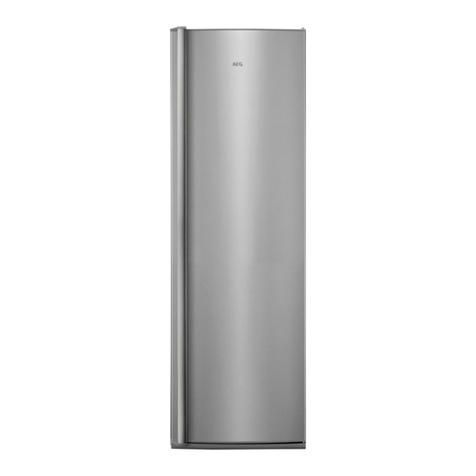
AEG
AEG RKS638F6MX User manual
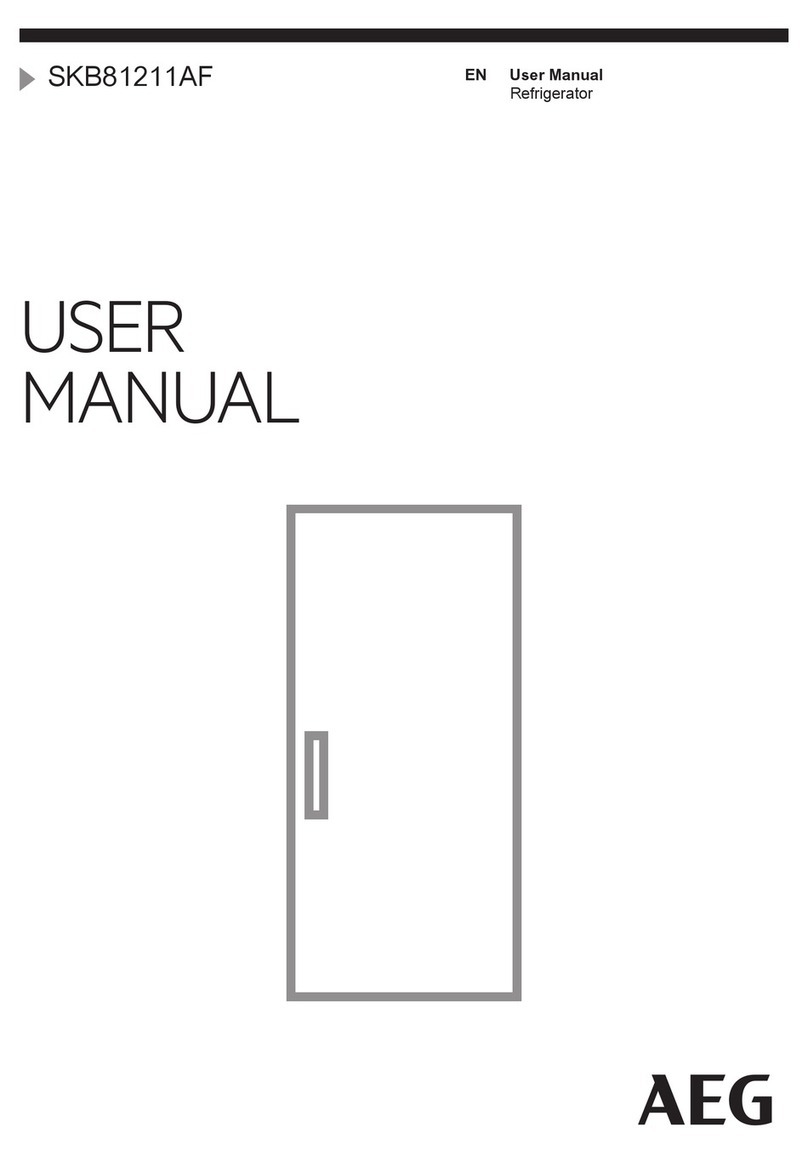
AEG
AEG SKB81211AF User manual
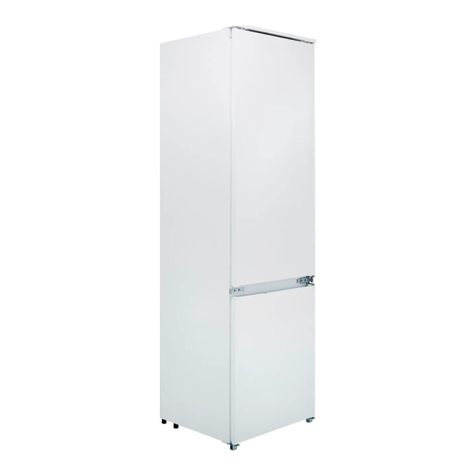
AEG
AEG SCE819E7TS User manual
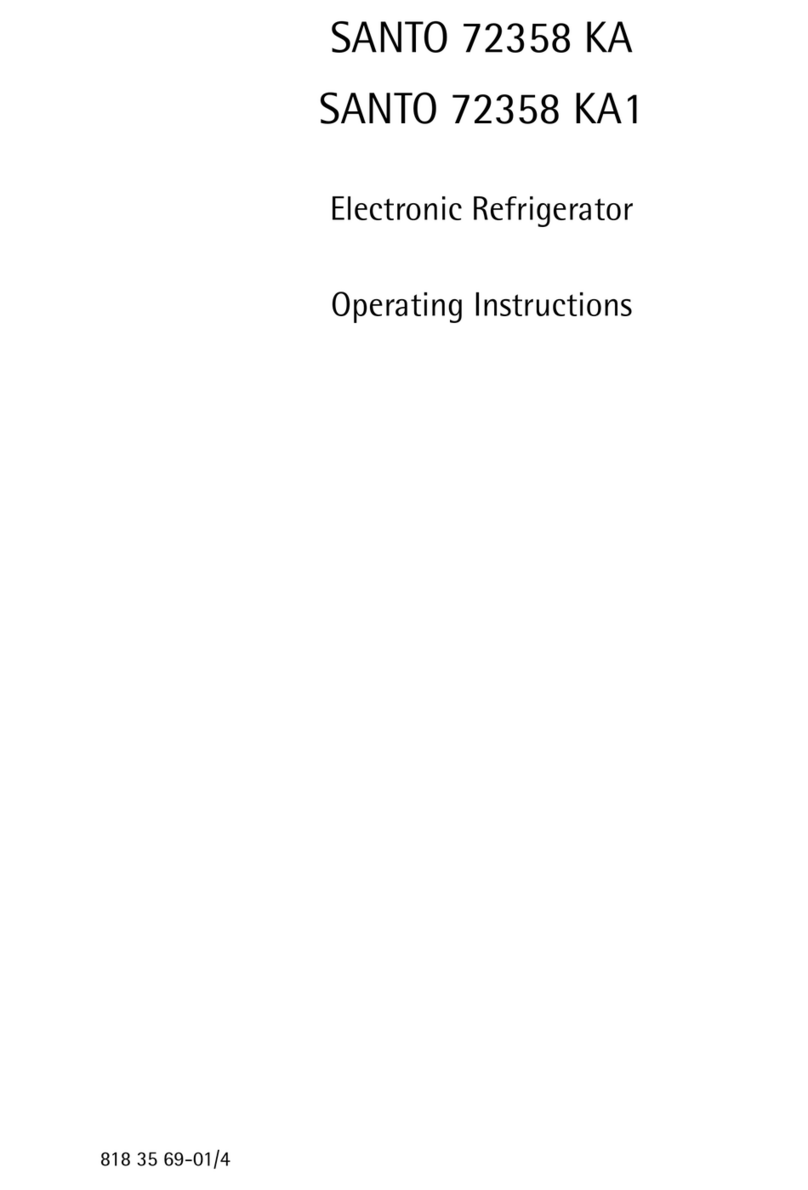
AEG
AEG SANTO 72358 KA User manual

AEG
AEG FRIDGE-FREEZER User manual
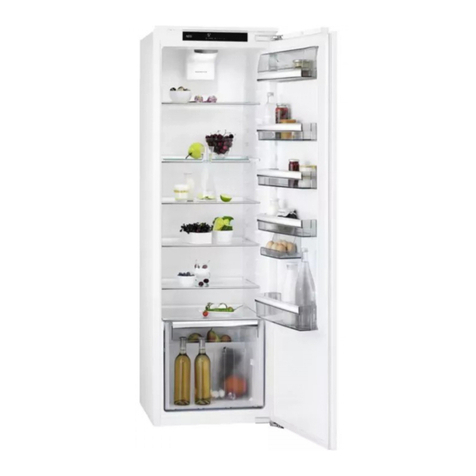
AEG
AEG SKE818E1DC User manual

AEG
AEG SANTO 70342 KG User manual
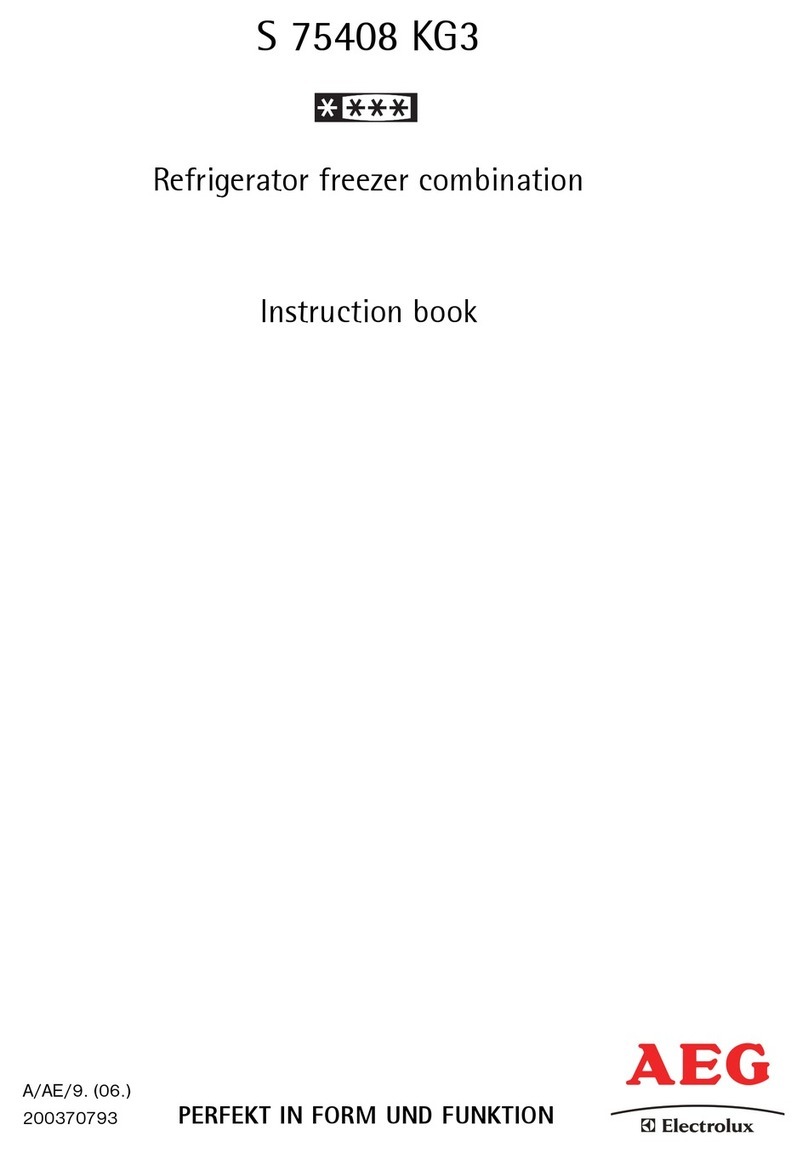
AEG
AEG S 75408 KG3 User manual
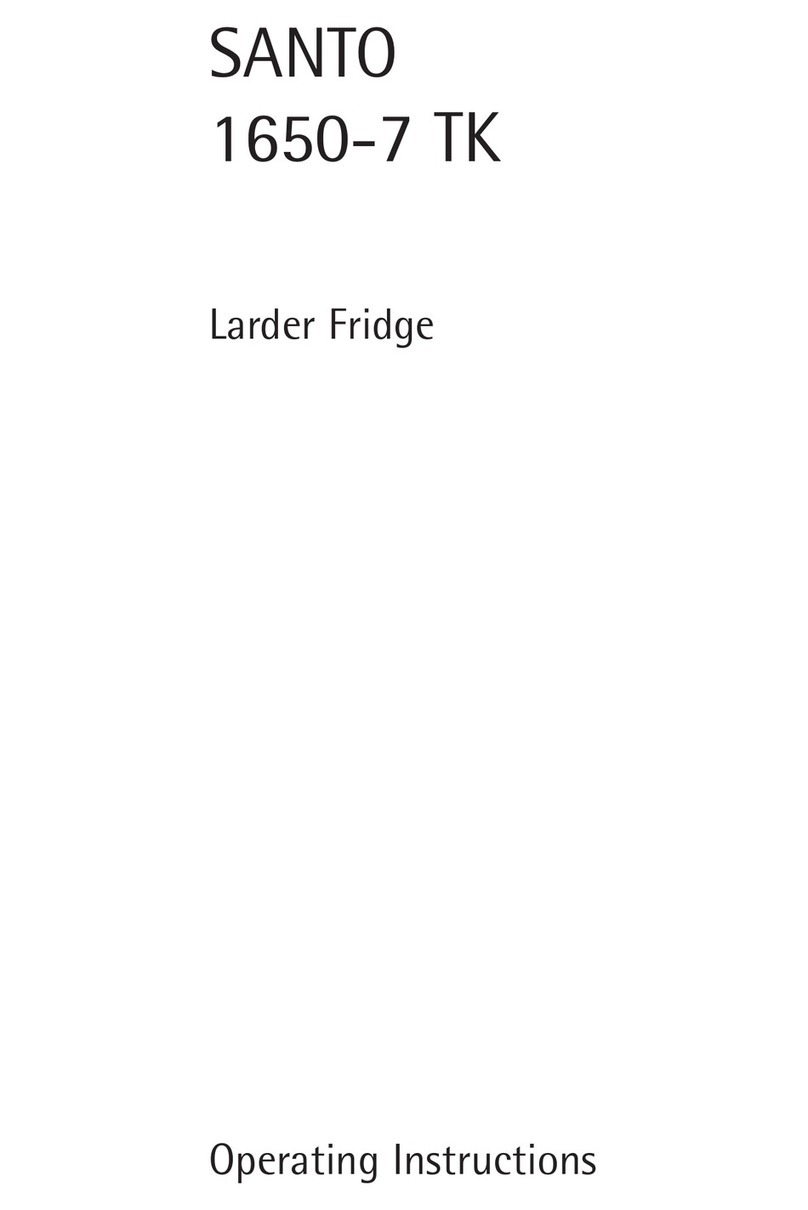
AEG
AEG SANTO 1650-7 TK User manual
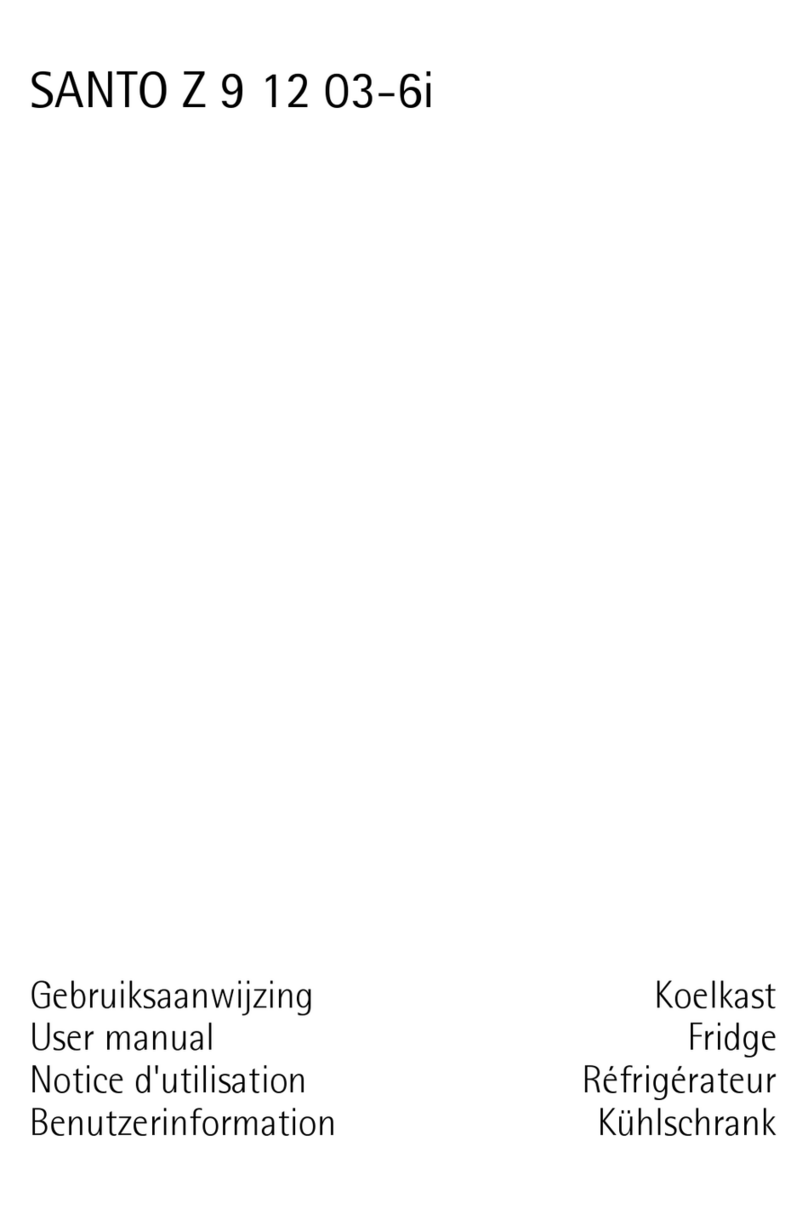
AEG
AEG SANTO Z 9 12 03-6i User manual

AEG
AEG Santo 1734-1TK User manual

AEG
AEG SFE888D1AF User manual
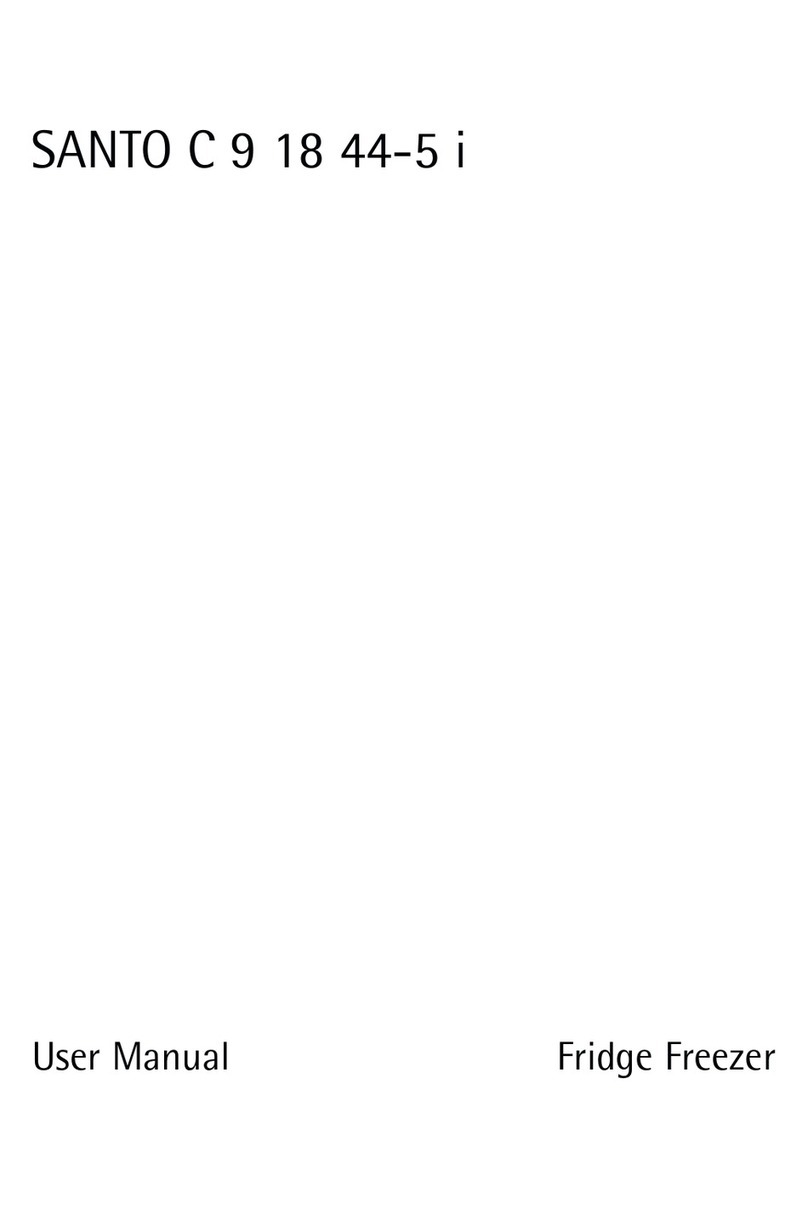
AEG
AEG SANTO C 9 18 44-5 i User manual
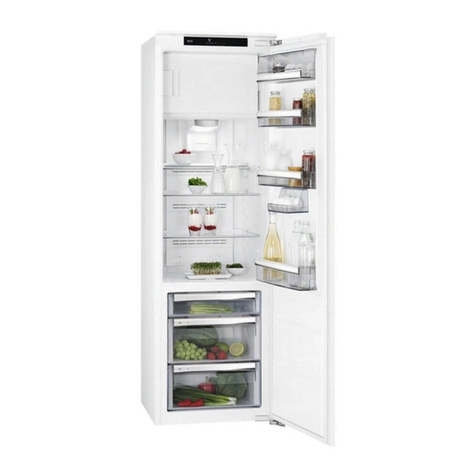
AEG
AEG SFE818E9ZC User manual
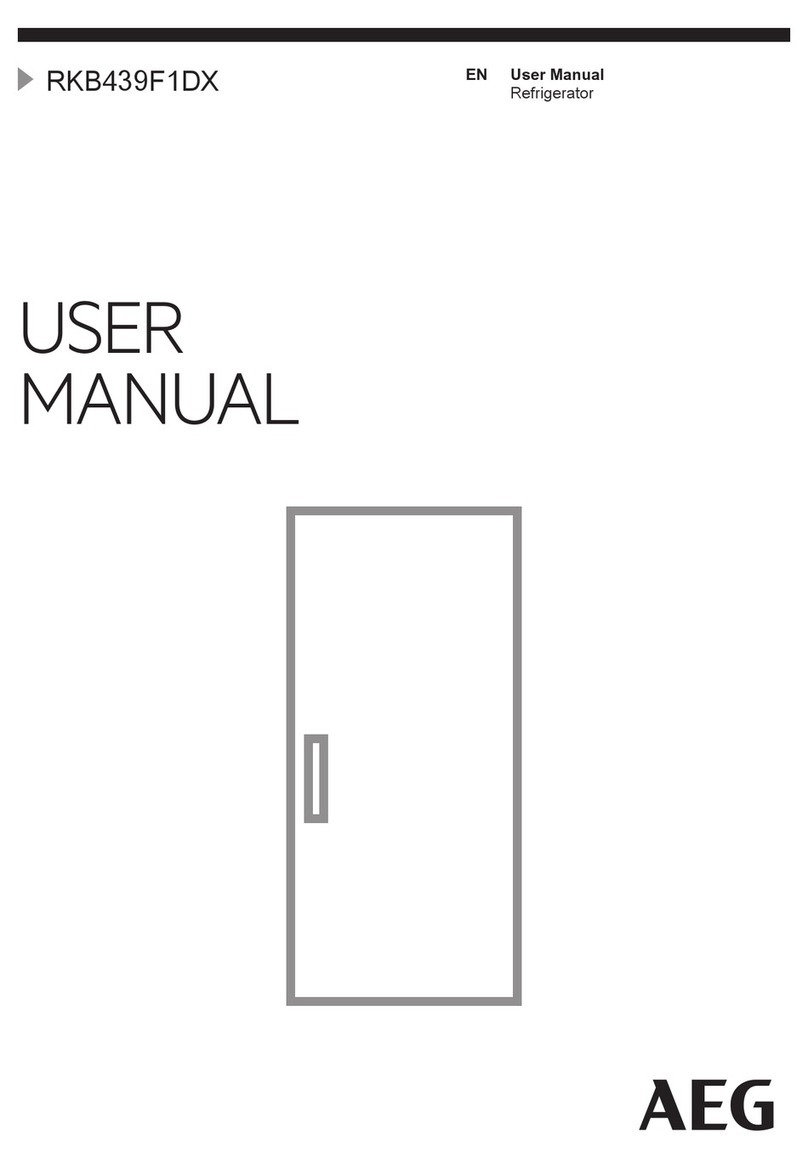
AEG
AEG RKB439F1DX User manual
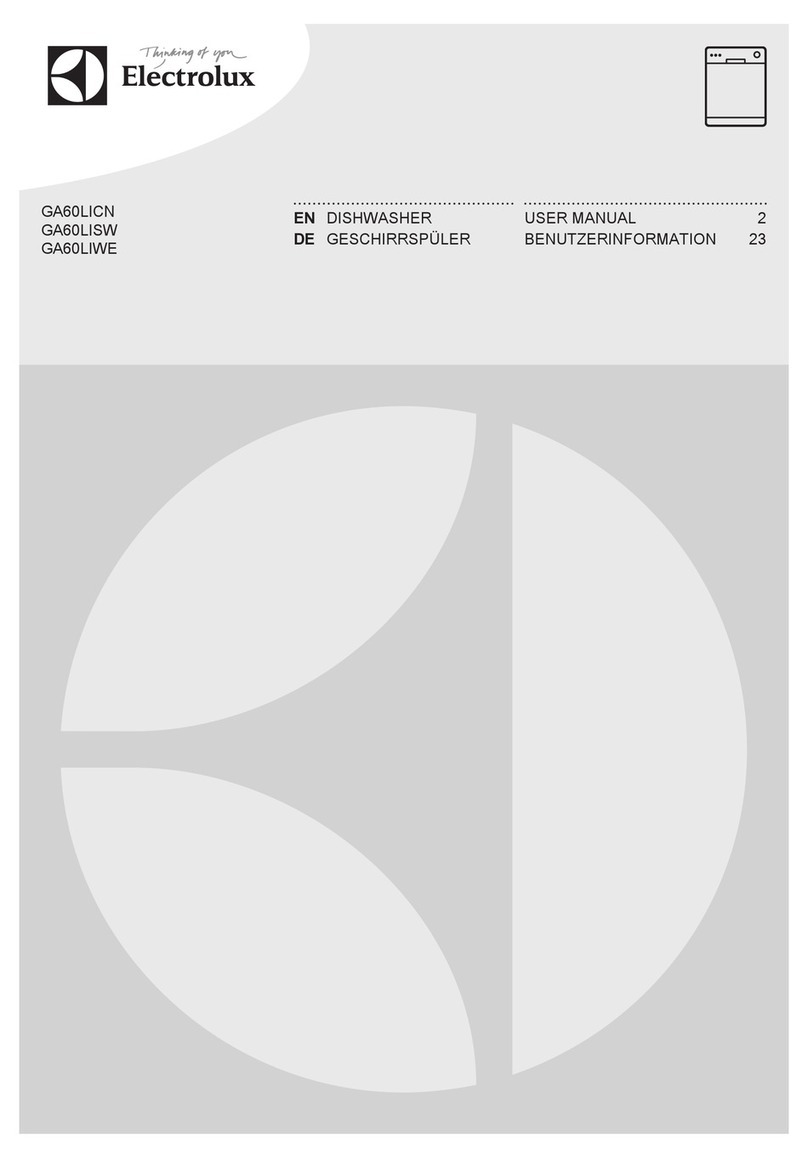
AEG
AEG SKD71813C0 User manual
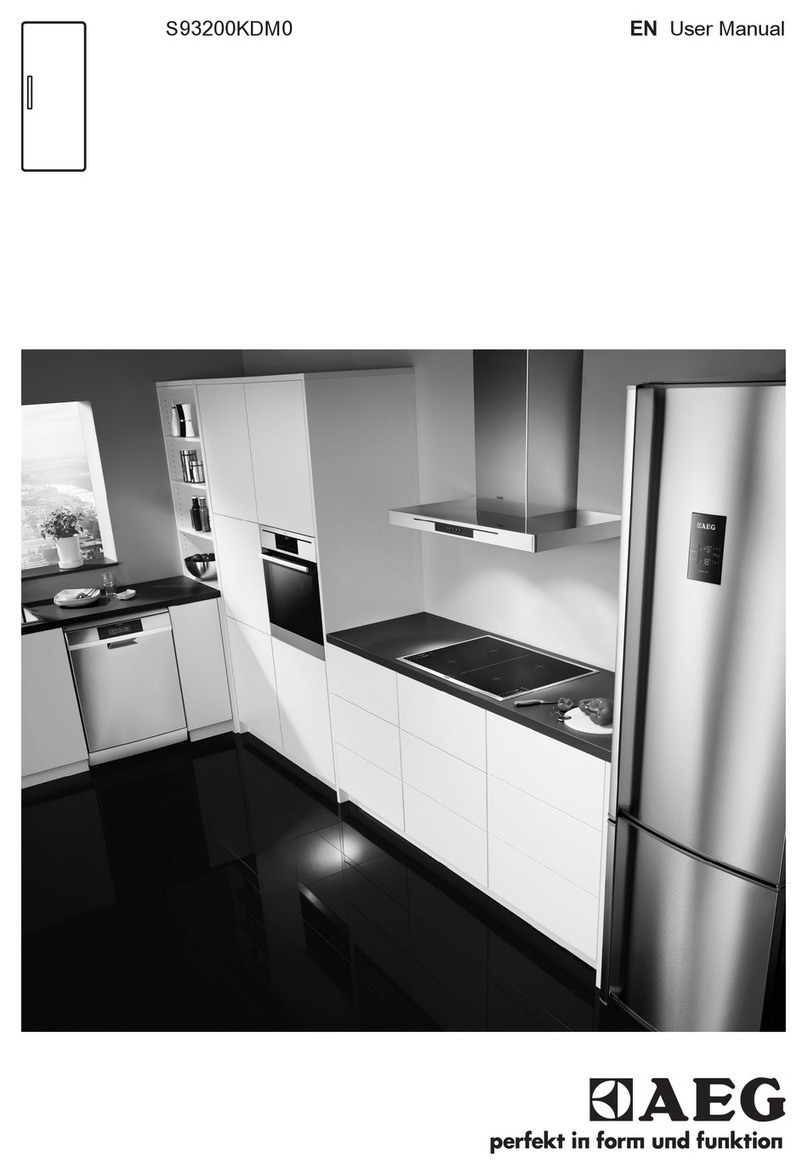
AEG
AEG S93200KDM0 User manual
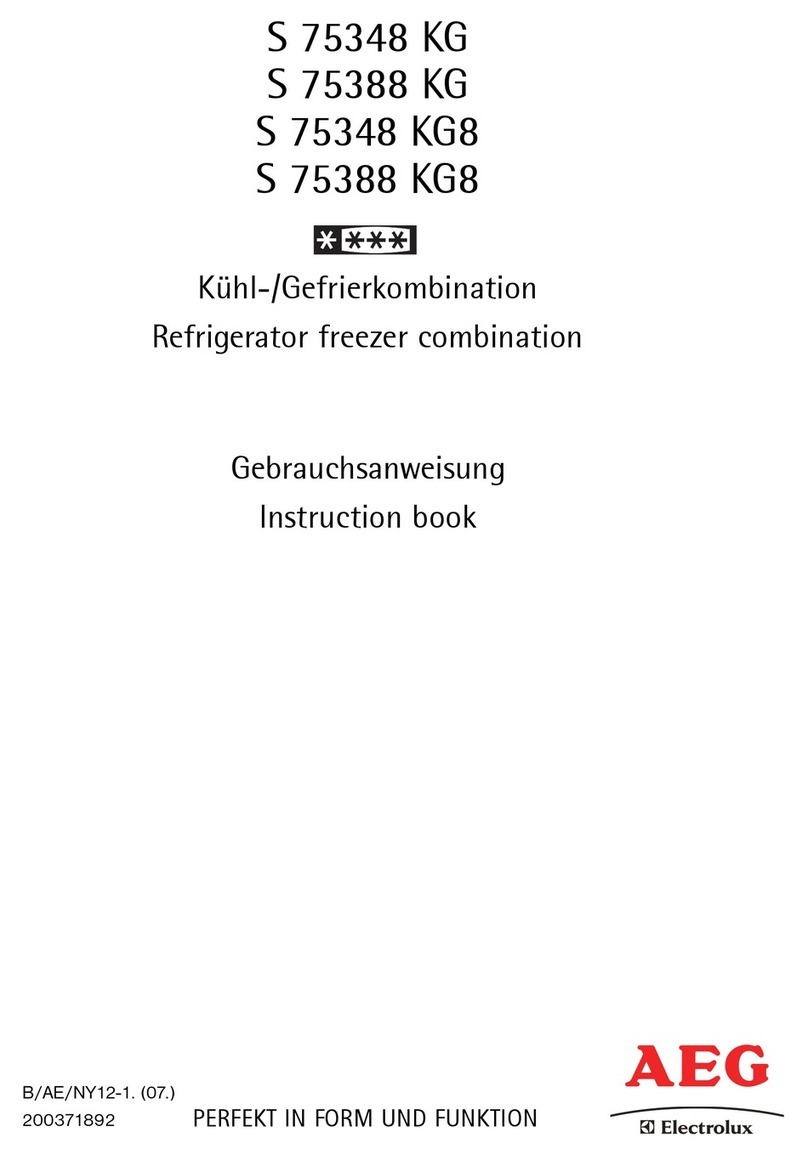
AEG
AEG S 75348 KG User manual
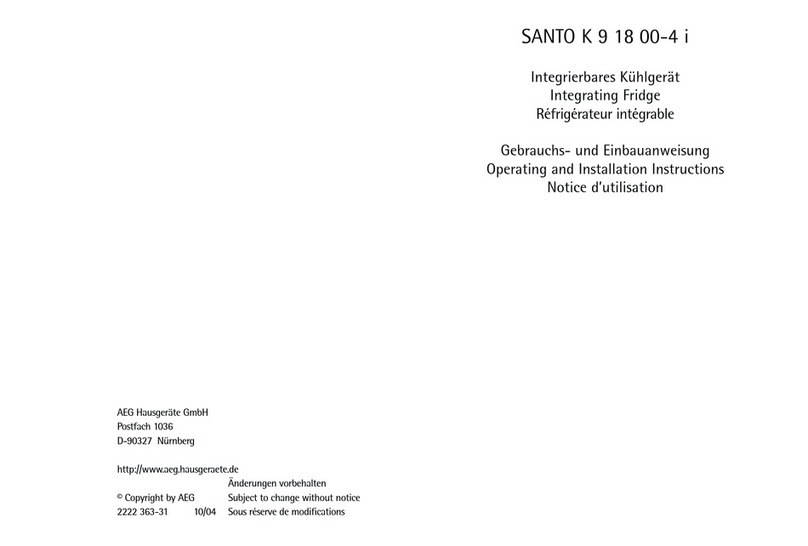
AEG
AEG SANTO K 9 18 00-4 i User manual
